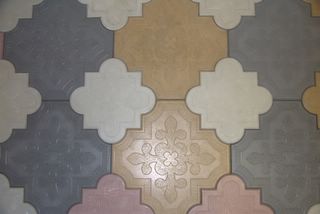Double-glazing reduces heat loss through your windows. You can save money on your heating bills. *However, it will be a long time before you save enough money equal to the cost of the windows*. If you can't afford to replace *all* your windows, choose the rooms that cost you the most money to heat.
Double-glazed windows come in a variety of sizes and styles. Check for any planning restrictions on your house due to age and location. Sometimes planning permission may be required, in the case in listed buildings and conservation areas. Also if you are converting a flat window into a bay window. Check this with the local authority.
Don't rely on the Yellow Pages or advertisements to choose a supplier. Anyone can place an advert, join a trade body, or display badges they're not entitled to.
Always use a reputable company that you have had independently checked out. Don't rely on the fact that you have heard of them as even some of the biggest advertisers may have had several incarnations. It's very easy in Britain to shut down one company and open up again under a similar name.
A 10% deposit is normal. A larger one is appropriate only if the work is 'bespoke' - such as unique timber window designs. Try to pay in stages according as the work in completed, and withhold the final payment until the work is completed to your satisfaction. Do not go for the cheapest quotation. There's a price point below which you'll be buying rubbish. Do not try to beat the price down too much. Less professional suppliers will agree to it, but sell you short later. Get the best you can afford. Ask your supplier how long the delivery will be. Have this stipulated on your contract. Additionally ask for an estimate of how long the work will take to finish once they are on-site.
Always pay deposits by credit card, as this will afford you some level of protection under the Consumer Credit Act. If the company will accept credit cards for the whole job then that is even better. You have 30 days to make a claim with your credit-card company. You have to show how you were given bad goods or workmanship i.e. they contracted to give you X and gave you Y instead.
Check, double check and get independent advice on the contract before you sign, as some contracts are considerably more onerous than others.
The best way to avoid salesmen's traps is to be sure of what you want before the salesman arrives in order to present him with your requirements and use that as your bargaining chip. Getting a specific quote against a specific set of requirements is the only way you can be certain of getting like for like quotations and getting the best prices to compare at your leisure. Ask if your chosen double glazing installer is a member of the Glass and Glazing Federation, check for FENSA accreditation and make sure that all products carry the safety standard kite mark.
Company checks to carry out:
How long have they been in business?
Check with Companies House.
What guarantees do they offer?
Are they insurance backed, lifetime or limited, are they transferable?
Membership of independent or paid for trading organisations.
These could include:
G.G.F - Glass and glazing federation
B.P.F - British plastics federation.
F.M.B - Federation of master builders
Conservatory council
Conservatory association
Consumer protection association
Guild of master craftsman
E.B.C - European builders confederation
Quality standards:
BS5750
B.B.A certification
Public liability insurance.
Will the fitters and the company be covered if something should go wrong? You should look for at least 2 million pounds cover and check the certification covers the people who are actually doing the work.
Product standards to check out:
B.S.I - British standards (kitemarks), for locking, security, safety, product, glass etc.
B.B.A - British board of Agrement
FENSA - Document L of the building regulations.
You should make up a comparison checklist and confirm all claims independently of any sales claim or literature. The *good* contractors get work by word-of-mouth referrals from previous clients. They've plenty of work to keep them going, and so are worth waiting a few months for.
The bad ones are doing too many jobs at once, moving workers from site to site, don't supervise them properly, and thus do poor work.
Ask yourself:
Have I been given:
1. Full and honest information.
2. Samples
3. Installations locally to look at
4. Recommendations.
5. The small print
6. Acceptable levels of deposits and payment terms
7. Full drawings and specification (if you don't have them prepared first).
8. Time to think!
___________________T. O'
Donnell (
http://www.tigertom.com/double-glazing-uk/index.shtml) offers double glazing quotes, advice, and an ebook, in London, UK.
COPYRIGHT: You have permission to publish this article electronically or in print, free of charge, as long as the bylines are included. You must publish the article AS IS. Do not modify, alter or edit it.
You are allowed to format the layout of the article for proper display in your website or ezine, so long as the text, hyperlinks and paragraph breaks are not changed or deleted. If presented in a HTML document, any hyperlinks present must be active, clickable, and go direct to the websites they represent i.e. no re-directs.
Notifying the author is not required, but doing so is appreciated, at
http://www.tigertom.com/contact.htm.



